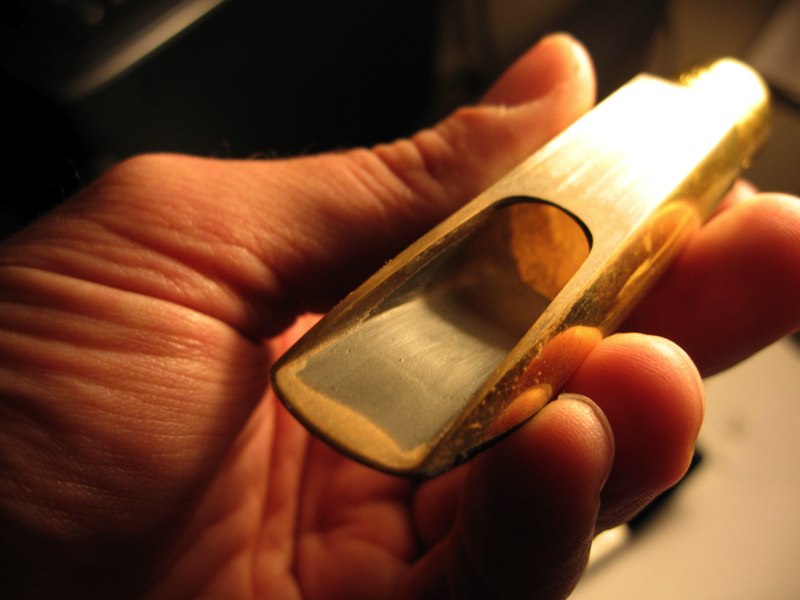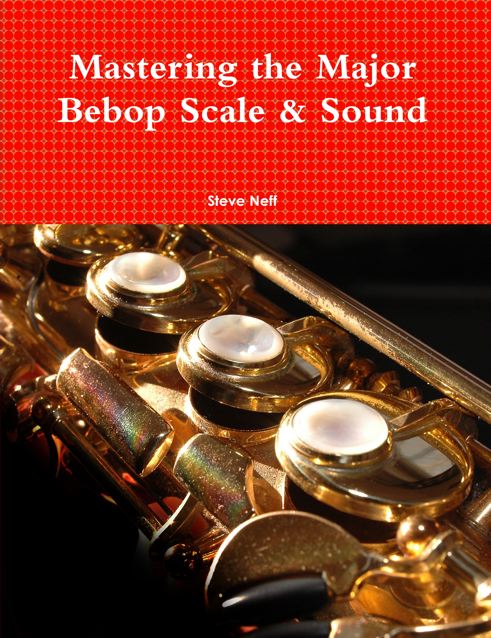This was on one of the google forums back in the late 90’s. I never heard of Jon Van Wie or his work before this but reading this post you can sense the love, passion and focus he had for saxophone mouthpiece refacing. Soon after reading this, I sent Jon Van Wie a few mouthpieces to reface for me. My main gigging tenor piece is a piece that he worked on. The JVW Otto Link Super Tone Master 8 that JVW put an added baffle in. The baffle Jon put in it is just like he talks about in this post he wrote below.
Another mouthpiece that I sent Jon to work on and that I still have is my Early Babbitt hard rubber Otto Link. I’ll never forget when Jon called me up one night all excited about that Otto Link and how well it played. He just kept talking on and on about how it was the real deal. He was so excited. Jon has since passed away and many sax players miss him dearly. I just found this post and wanted to share it with all of you. I was just sitting here reading it again and found myself getting emotional just from the passion of his words about working with saxophone mouthpieces. Jon was a true craftsman and I miss him.
The writings below were written by Jon Van Wie:
“I’m forever trying to find the perfect mouthpiece for myself and up till now, I’ve come up empty handed. I can make them all play, but I’ve been doing some experiments that have given results that have changed the way I view everything.
There’s a secret locked inside, and I may have found it. It has to do with the facing curve, baffle and chamber relationship. They together provide the best possible sound in your horn.
I just did two Otto Links for tenor. (Otto Links have a sound that a lot of players call “tubby”. Not modern in any way.) In the past I would add a little baffle right behind the tip rail and the sound would get a zing it didn’t have before (I would leave the chamber alone). The catch was, how the piece would act in the extreme altissimo range. The notes would pinch off at a certain spot and generally speaking, the upper register would always sound a little thin compared the rest of the horn.
To alleviate that problem, I cut the upper baffle lower and added material behind the upper baffle down into the chamber, filling in the whole circle, side rails as well. The pieces finally had the same punch in every register! They both had a very loud and an easy to control voice, with no chirping! I hit on something that is so vital to the function of the saxophone mouthpiece that it’s one of the biggest advances that I’ve ever made! I just sent the mouthpieces back to their owners. I can’t wait to hear their views on how they play!
I think there’s a place for every piece to be that makes it the best it can be, but I don’t think its possible to find without the player. I think everyone agrees, when something’s right! The question is for whom? Each player has a different oral cavity that makes their sound their own. The resonant cavity that the reed creates with the baffle and facing curve play a big role in your sound.
Finding the perfect baffle, chamber and facing curve for you is something that requires a great deal of research.
Maybe your piece is not what it should be for you. If you think that, you
should tell me what you think and I will give you a hand.
***The epoxy I use to expand the inside of the piece is non-toxic when cured and will NOT fall out with prolonged use.
This experiment started a few months back when the great player Dave Tofani from New York (who plays with everyone) called me after seeing some of my work that one of his students Mike Lawrence had. (I did 5 Florida Otto Links, 2 Slant Otto Links and a Hollywood Dukoff for Mike!) Dave had a vintage Florida Otto Link 8 that he had since it was new and it never played right. He hoped I could do something with it.
Just because it’s a Florida Link means nothing. Just because it has the size stamped on the side doesn’t mean it was handed down by God. The facing was installed poorly and it was even crooked out at the tip.
So, I refaced Dave’s Otto Link 8 tenor sax mouthpiece and sent it back to him. Dave told me that the mouthpiece was greatly improved and now was a Link with “zing”, but what he really wanted was a more modern sound.
The tubby-ness on the bottom of the stack was something he wanted to lose. I told him that I didn’t like to add baffle to Florida period Otto Links because of their value. He told me that he didn’t care, he just wanted the mouthpiece to work. He was still using a mouthpiece that his teacher, Joe Allard, had given him years ago. It had a baffle in it machined from brass.
I installed a big roll over R&B kind of baffle for Dave and sent it back. After playing the mouthpiece a bit, Dave came to the conclusion that the piece was now too bright in the upper register. He complained that his high altissimo notes were too thin sounding, yet he was pleased that it lost the tubby-ness, so he sent the mouthpiece back for a readjustment. With the mouthpiece he sent a photo of his favorite tenor sax mouthpiece and I could see that the baffle was long and low.
I lowered the baffle and hit on something that Dave could really make sing. This led me to believe that the angle behind the tip rail going into the chamber was playing a crucial role in the altissimo range. The quality of the notes in the altissimo was Dave’s thing. He didn’t want the extremely high notes to sound thin. Mission accomplished!
The next mouthpiece that I wanted to experiment with was a butchered Otto Link tenor mouthpiece. It was owned by my client David Mann (Tower of Power). The mouthpiece had the chamber expanded with a Dremel, and a primitive looking baffle was added. I popped the baffle out and there were deep grooves in the baffle area that had the lumpy baffle stuck to it. Now I could see that not only did I need to add a new baffle, but I also wanted to fill back in the chamber that had been mutilated.
I could tell by looking at the mouthpiece that it was an Early Babbitt Otto Link and they have extra large chambers to begin with. I thought it would be good to shrink the chamber a bit from where it was to begin with (Like a Florida Link). I kept Dave Tofani’s baffle profile in mind and I re-constructed the baffle. The mouthpiece in the end didn’t sound vintage unless I used little air, then it sounded warm, but not tubby. Then when I pushed the piece it responded evenly, even in the altissimo range! It was also about twice as loud as an Otto Link. The work I did with Dave Tofani really paid off. It seems his idea about the baffle profile was hitting on a hidden truth inside the Otto Link blank for a modern player.
I sent that piece back to David and he’ll be getting it on Monday. I’ll post his findings. I think I know what he’s going to say already. The next Otto Link I worked on was owned by Dirk Zeylmans. It was also an Early Babbitt Otto Link. Dirk gave me the freedom to do what ever I wanted. He’s going to be very happy with the mouthpiece! It spoke with the same power as the others. I think the old Otto Link mouthpieces were good for the time, but now players need a little more cutting power for a modern music application. Not bright and edgy, but loud and full.
Players ask me all the time, what metal piece do you think I should buy? I honestly don’t know. I think everything is made today in such a rushed fashion that most of them need to be finished. It takes time to do really excellent work. “-Jon Van Wie




I had a JVW refaced Meyer that was my favorite piece. I was struck when I had Jon do the piece how polite and humble he seemed to be. When I got the piece back, I could tell he had done some very nice work on it, but when I tried it, I didn’t like how the piece played. I couldn’t get it to sing for me. So, I put it in a drawer and didn’t touch it again for about a month.
When I tried it a month later, holy smokes! That piece was absolutely amazing. I played that piece for several years, never once feeling the need or even desire to look at other sax mouthpieces. I emailed Jon and relayed the entire experience to him. He was so thrilled that I had taken the time to try the piece again. He wrote on about how many players didn’t spend enough time with a piece before deciding they don’t like something about it. He seemed genuinely pleased at my becoming comfortable with the piece he did for me.
A few years after Jon’s passing, the piece hit the stage floor at church, breaking the tip into little fragments. I probably looked as if I were about to cry. I still have the piece in a drawer. I’ve since spent far too much money looking for a piece I like anywhere near as well.
Man, that stinks. I know if that happened to me I would be devastated. I’ve been looking for someone that will copy it for me but haven’t found anyone I really know well yet that can do it.
We all cringe at the thought of that happening to any saxophone player. I’ve bought some pieces from Ed Pillinger in London England. I love the pieces he’s made for me and I know that he is known for making wonderful copies of pieces on request. He is very kind, knowledgeable, and such a gentleman. You can get his contact information at http://www.edpillingermouthpieces.co.uk
Good luck, rob…
I had the great privilege of having a mouthpiece worked on by Jon, but also had the pleasure of numerous conversations with him. Sometimes I would call Jon if I wanted his input on any experience he may have had with a particular mouthpiece. Or sometimes I had a technical question about mouthpieces in general. Jon was always willing to take the time to talk shop with me. And Steve N, you are right – Jon had a great passion for his work and cared very much about helping each client achieve the sound they were aiming for. Jon was a true artist, and is very badly missed.
I actually have 5 JVW refaced mouthpiece here now that I’m trying. He did do amazing work. I’ll never forget that phone call where he called me out of the blue. He was just talking and talking about mouthpieces and music and I remember thinking “Man this guy loves this stuff……….” The other guy that was like that was Ralph Morgan. He called me up once and was the same way. Just excited about doing what they do……….!
Jon was an amazing guy. I grew up in Waverly NY and my aunt happened to be dating Jon when I was about 6 or 7. I remember watching him work on mouthpieces and listening to his dobermans howl as he would play. I remember Christmas time with his daughter Hannah who ended up being the Prom Queen just this year, I couldn’t imagine how much she misses him. Jon would have my cousin and I sit in the kitchen below the clock against the wall and make us guess the time while he baked pumpkin seeds after Haloween. Little things like that were fun as a kid. When I was 9 I moved to Buffalo and never saw Jon again. He talked to my dad who happened to be Jon’s accountant and I saw an email to my dad about his cancer and how my dad wanted to bring him up near buffalo to a better hospital. I heard he fell in love after my Aunt left him and he passed one night in his sleep. I miss him a lot and think about him all the time.
Thanks Johnathon. It’s so great to hear a personal recollection about Jon. I’m sorry for your loss. We in the saxophone community all miss him and think about him every time we play his great mouthpieces.
I just wanted to say how much this blog moved me. I just missed getting a Jon Van Wie Meyer Alto on ebay. I never met Jon, but I might have had a conversation with him back in the day, when I was very active calling mouthpiece makers and refacers trying to understand the magic of mouthpieces. If memory serves correct, he worked for Bob Ackerman for a while at the beginning of his career, no?
At any rate, it is a loss that he is no longer with us. I am wondering; how many mouthpieces do you think he might have refaced in his career? And how many do you think added baffles to vs. just doing facing work?
Thanks.